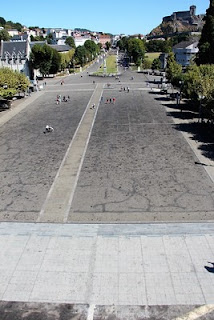這個網誌 ( Blog ) 是得到老同學韓道豐的授權,用來轉貼他周游列國的游記,内容圖文并茂, 生動有趣。---------------- Re-posting of travel stories by old classmate Hon Too Fang, with permission.
Wednesday 15 April 2020
The Istanbul Archaeological Museums in Istanbul, Turkey
The delightful old town of Cordoba, Spain
湖南省湘西的凤凰古城 The old town of Feng Huang in Hunan, China.
WS 138: 湖南省湘西的凤凰古城 The old town of Feng Huang in Hunan, China.
凤凰古城位于湖南省,湘西土家族苗族自治州的西南部。人口约五万,苗族,土家族和汉族聚居。现有的布局始建于清康熙四十三年,历经300多年,古貌犹存。
凤凰古城分为新旧两个城区,旧城依山傍水,沱江穿城而过,以回龙阁古街为中轴,连接无数的石板小巷,沟通全城。旧城有百多栋明清时代的民居,有的已改为商店,酒吧或小客栈。还有三十多座祠庙馆阁。凤凰古城是中国的著名的古城之一。
我们在2009年曾来此旧城区一游。最先的照片所示是沱江两岸,水车。一条小巷的景色和一间有名的祠庙:天后宫。还有一位师父在制作凤凰特产:姜糖,和苗族服饰的小玩偶.
这里较特别的建筑是沱江两岸的土家吊脚楼,依山就势而建,上中层通风防潮,阳光充足,适居。下层是杂室或家禽栏。都是明清建筑。在清浅的沱江上泛舟是经典旅游配套之一。最后两张照片是这里的夜景,在沱江上放莲花灯也是一个旅游节目,看这些卖灯的女孩子都愁眉苦脸,生意该是很差。
(照片质量较差,毕竟2009年的数码相机像素有限)
The old town of Feng Huang (meaning: phoenix) is located in western Hunan Province in China. It has a population of about 50,000, with Miao, Tujia and Han people living together. The existing layout of the town is dated to the Kangxi period in the Qing Dynasty, or about 300 years ago.
The old town is located at a valley dominated by the main street. There are more than a hundred houses from Ming and Qing Dynasties, some of which have been converted into shops, bars or small inns. There are more than 30 temples and pavilions here. It is in fact one of the famous old towns in China.
We visited this old town in 2009. Shown some typical scenes. A master is shown making the special ginger candy. A feature worthy of special mention is the stilt building on both sides of the main Tuojiang River built by the Tujia people. The upper levels are ventilated, with plenty of sunlight and are living quarters. The lower floors are stores and livestock pens. Cruising on the clear and shallow Tuojiang River is one of the classic tourist packages.
The last 2 photos show the blurry night scenes here. Floating lotus lanterns on the main river is also a tourism attraction. The girls who were selling the lanterns looked very grim. Business must be poor.
The ruins of Acropolis in Athens, Greece
Lying low at the Dead Sea, Jordan/Israel border
The Sanctuary of Our Lady of Lourdes, France
*WS 135: The Sanctuary of Our Lady of Lourdes, France*
Lourdes is a small town in southern France. From 11 February to 16 July, 1858, the Virgin Mary, mother of Jesus, was said to have made 18 apparitions to a 14 year old simple farm girl, Bernadette Soubirous in a cave near a village in Lourdes. The girl’s later visits to the cave were followed by thousands of curious people. No other people could see the Virgin except her. Various miracles were said to have occurred at the place during that time, under the watchful eyes of the anti-religious government officers with the incidences well documented. One particular case was a clear spring appeared the next day on the spot where the girl dug into the ground and drank some muddy water the day before.
The water from the spring has since became the source of claims of miraculous healing. The Catholic Church has since set up a Medical Bureau manned by medical specialists in various fields (may not be Catholics) to examine the truth of the claimed healing. Since 1905, more than 7000 cases were submitted and by 2017 the Bureau declared that 69 of the healing cases are considered “beyond scientific explanation”. The religious called them miracles.
In 1862, the Catholic Church declared that the apparition story was “worthy to believe”. It is up to the followers to believe it or not. A small chapel was first built here in 1866. Now the sanctuary is a complex of many churches and other buildings, to cater for some 6 million pilgrims a year, for hope of healing or spiritual renewal. This is a popular pilgrimage site for Malaysian Catholics.
In 2016 we made a 4 night pilgrimage stay at this town of Lourdes, which has more hotels in France than any other cities except Paris. The first photo shows the cave where the Virgin Mary was said to have first appeared and a status of her, the likeness as described by the girl Bernadette who later became a nun. Many of the Malaysian Catholic churches have such a grotto set-up outside their church buildings. The next is a scene of a morning mass held in front of the cave.
The 3rd photo shows the Crypt, the small rock cave chapel blasted out of the rock slope completed in 1866. The next shows the Basilica of the Immaculate Conception, the 2nd of the churches to be completed, in 1876, built over the Crypt.
The 5th photo shows a photo of our big family group in front of the 3rd church constructed: the Rosary Basilica completed in 1901. The next shows the lateral view of the two basilica mentioned earlier. The 7th is the interior of the Basilica of St. Pius X, also known as the Underground Basilica, the largest of the churches, completed in 1958. The capacity is 25,000. The 8th photo shows the main open space, called the Rosary Square, where processions are held.
The last 2 photos show scenes of the daily prayer procession at the Rosary Square. There are many volunteers to help the sick or handicapped pilgrims.


























































